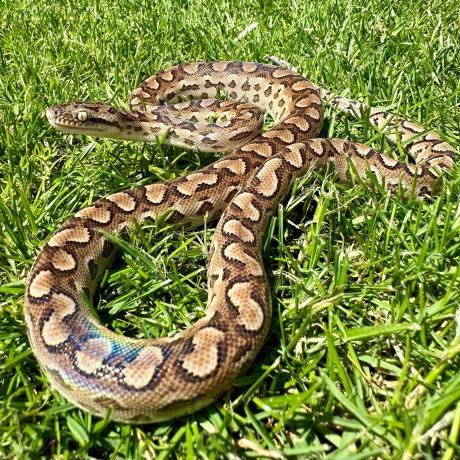

The Argentine Rainbow Boa is a slender bodied boa that is semi-arboreal. They have the typical iridescent rainbow shine and they do not lose their patterning as they mature.
| Origin | Argentina |
|---|---|
| Environment | Humid Forests |
| Adult Size | 4-6ft |
| Suitability | Beginner |
| Lifespan | 20 years + |
| Temperament | Very Docile once handled |

Unlike other species of Rainbow Boas, Argentines keep their stunning colour and patterns from young to adulthood. The underside is cream which gradually turns to tan along the side, then a darker shade of brown on the back. Patterning along the side of the body consists of brown circular dots, some look like eyes with a lighter colour within the circle. Tan saddles with a dark outline are present from the neck to the tip of the tail. As the name suggests, Rainbow Boas have an distinctive iridescent sheen which shimmers on their scales when under light.
Personally, one distinctive part of the Argentine Rainbow Boa are their eyes as they seem to protrude, giving them a ‘googly eyed’ look. The head has a dark V shape from the snout to either side of the jaw line, an inner line in the centre of the head and a line from the eye to the back of the neck. Small heat pits are present as with all Boa/Python species.
This species can reach up to 6ft long, however, tend to average around 4-5ft, females are generally larger than males. Described as a slender snake, these have some girth to them but we wouldn’t class them as heavy bodied. Handling is pretty straight forward, younger snakes can be a little more defensive, however, we have found once picked up, they calm down in your hand.
Argentine Rainbow Boas enjoy exploring their environment and are classed as semi-arboreal. They are native to the North and Central regions of Argentina, found living within humid forests.
Argentine Rainbow Boas do great in a Bio-active setup, however, we understand that this might not be possible for everyone to accomplish. Provide an adult with a minimum vivarium size of 4x2x2ft. Younger snakes can be housed in smaller enclosures, but bear in mind that these like to climb and explore so the bigger the better.
Provide Ferguson Zone 1 UVB lighting and ensure to select the correct UVB bulb depending on the height of the enclosure and distance from the bulb to the animal. We would recommend a guard around this as snakes do tend to wrap around the light fixtures which can cause harm/damage to the snake and the unit. This provides UVB that your snake will benefit from and it will show the iridescent sheen and make them look more attractive (if this is even possible!).
There are two ways of heating the enclosure; the first and best way is to use a basking lamp for daytime heat, connected to a dimming thermostat and a ceramic for nighttime heat connected to a pulse thermostat. Using this method allows a visual basking area during the day and the nighttime drop this species requires. If working to a budget, you can use a ceramic heater, but strongly recommend the use of a digital thermostat so you can increase/decrease the temperature as required at certain times of the day. Aim for a basking area of 27-32C (80.6-89.6F) during daylight hours and reduce to 22-25C (71.6-77F) during the night. It goes without question, the basking bulb/ceramic must be protected by a heater guard, otherwise the snake will burn itself.
The substrate should consist of a mixture of soil/coco fibre with orchid bark. An effective way to help keep humidity levels to 60-85% is to provide a humidity hide which will contain damp moss. This allows the snake to rest at higher humidity levels, especially when going through a shed without the whole enclosure becoming wet from condensation buildup. We would recommend lighting misting the enclosure to keep the lower end of the humidity level to 60%. Please note, this will drop at peak temperatures - another reason to have a humidity hide.
Natural and artificial hides can be placed throughout the enclosure to give them added security. Argentine Rainbow Boas are semi-arboreal, therefore providing climbing branches for them to explore is great enrichment. The use of cork branches with artificial plants/vines and a scatter of reptile safe leaf litter will give the enclosure that natural forest look.
Provide a large water bowl so the snake can fully submerge, this can be difficult as they mature, but we do offer larger bowls on our site to purchase. If the water is spoiled, use a reptile safe disinfectant to clean and add fresh water. The use of a dechlorinator will remove unwanted chemicals from tap water and add extra electrolytes which is beneficial for your snake.
Feeding is relatively simple as they will take a variety of prey items from mice, rats and the occasional chick (when adult). Young snakes tend to feed on Mouse Fluffs, which increase as the snake grows to adult mice or smaller rats. Always use feeding tweezers when offering food as accidents can happen and wash equipment and hands afterwards.